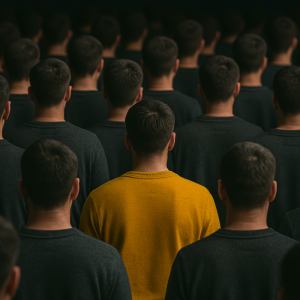Good Enough Life

Key Takeaway:
Consumers are redefining success—choosing sufficiency over aspiration and prioritizing emotional well-being. With 64% of young people (Deloitte, 2024) believing home ownership is out of reach and 48% of global creators monetizing passion projects (Adobe), many are rejecting hustle culture in favor of a “good enough” life. This shift favors present enjoyment, intentional consumption, and radical rest. Trends like de-influencing, “bed rotting,” and tea tourism reflect a growing desire for balance and micro-joys. For brands, the opportunity lies in designing for sufficiency, enabling under-consumption, and delivering everyday emotional value.
Trend Type: Social & Business
Sub-trends: Levity & Laughter, Good Enough Life
From Aspirational To Sufficient
Young people are abandoning broken milestones and rewriting the rules of adulthood. According to Deloitte’s 2024 Global Millennial Survey, 64% of Gen Z and Millennials believe owning a home will be difficult, and 47% feel that starting a family is out of reach. This sense of systemic blockage—amplified by housing protests across Europe in 2023–2024—has prompted a shift from traditional definitions of success (home, career, family) to values like mental health, autonomy, and flexibility.
The “Good Enough” mindset, inspired by Avram Alpert’s book and Winnicott’s parenting philosophy, is gaining cultural traction. Rather than optimizing every moment for output, consumers are focusing on sufficiency over achievement. This is visible in the rising popularity of movements like “bed rotting” (Trendhunter, 2024), where Gen Z claim rest as a form of self-care, and in the growth of freelance and passion-driven careers: Adobe reports that 48% of creators worldwide now monetize their content.
Conscious Consumption, Complex Emotion
Consumers are navigating the tension between craving and control—intentionally resisting excess while embracing small joys. The 2024 Mintel Global Consumer Trends report highlights a transition from “achievement” to “positive perspective,” as consumers adapt to long-term uncertainty. This shift is reflected in what NextAtlas calls “Muted Desire”—a world where avoidance of temptation signals status, and consumption is increasingly shaped by intentionality and restraint.
Brands are responding with anti-consumption campaigns and minimalist experiences. For example, with Vinted’s “Too Many” campaign critiques clothing excess with exaggerated, meme-like imagery (watch below). Or Marsèll’s flagship store reduces product visibility to promote slower, more mindful shopping. Or even Cuyana’s April Fool’s “De-Influencing” ad pokes fun at over-hyped fashion trends, aligning with a growing movement on TikTok that encourages consumers to not buy what they don’t need.
Simultaneously, micro-moments of joy are gaining importance. These fleeting pleasures are more accessible than long-term happiness, offering daily respite through tea rituals, birdsong apps like Merlin and BirdNET, or dopamine-stimulating wearables (Trendhunter, 2024).
The Good Enough Economy
New behaviors are reshaping markets—prompting brands to design for moderation, simplicity, and emotional resonance. Consumers are increasingly skeptical of promises of endless growth and constant optimization, presenting both a challenge and an opportunity for brands to rethink their value propositions.
To stay relevant, brands are designing for sufficiency, offering “just enough” rather than excess. Subscription boxes like TheraBox and Universal Yums deliver bite-sized self-care, tapping into the desire for low-commitment, emotionally satisfying experiences. They are also enabling under-consumption by rewarding durability, sharing, repairing, and even saying “no,” as seen in campaigns like Vestiaire Collective’s mindful Black Friday. Furthermore, brands are centering emotional well-being by supporting joy, play, gratitude, and rest. Campaigns like ASICS’ Desk Break, McDonald’s “The Meal,” and Duolingo’s unhinged humor demonstrate how levity can build authentic connections.
As Mintel’s “Being Human” and “More Than Money” trends suggest, brands that succeed in this new paradigm will be those that respect consumers’ emotional bandwidth—and meet them where they are, not where they “should” be.
Use Cases
Good Enough Life: The ad premiered ahead of World Mental Health Day and features Brian Cox, serving as a public service announcement that urges office workers to take a break for their mental health.
Good Enough Life: The films feature striking visuals that depict people submerged in seas of clothing, confronting viewers with the stark reality of excessive consumption. By urging consumers to reconsider their relationship with clothing, the campaign encourages a shift towards more mindful and environmentally responsible fashion choices and supports the growing movement towards pre-loved fashion.
Good Enough Life: Vestiaire Collective, the luxury marketplace, has banned fast fashion from being bought, sold, or listed on its platform. Vestiaire said it would have been hypocritical to continue offering fast fashion on the platform when it’s no secret that the global fashion industry is one of the world’s biggest polluters, while denying workers a living wage. It now works on offering consumers alternatives such as wearing, repairing, recycling, upcycling and constructive donation strategies.
Use Cases
Sub-Trend Sources
Levity & Laughter: Adobe Creative Trends, Marian Salzman, VML The Future 100
Good Enough Life: Dentsu Creative Trends, Mintel Consumer Trends, Marian Salzman, NextAtlas Consumer Trends, Trend Hunter
What to Read Next
Balancing Reality
Rebalancing Digital and Physical Life This trend has been unfolding since the Covid era, when people rediscovered nature, in-person socialization, and tangible connections. In sum, as digital saturation grows, people[...]
Sameness
Sameness in the Algorithmic Age In a world where everything is optimized, everything starts to look the same. The rise of algorithmically driven platforms has accelerated the convergence of aesthetics,[...]
Energy Challenge
The Collision of AI and Energy Demand The rise of generative AI is not only transforming digital landscapes—it’s also reshaping the global energy equation. According to Deloitte, the rapid expansion[...]
What to Read Next
Balancing Reality
Rebalancing Digital and Physical Life This trend has been unfolding since the Covid era, when people rediscovered nature, in-person socialization, and tangible connections. In sum,[...]
Sameness
Sameness in the Algorithmic Age In a world where everything is optimized, everything starts to look the same. The rise of algorithmically driven platforms has[...]
Energy Challenge
The Collision of AI and Energy Demand The rise of generative AI is not only transforming digital landscapes—it’s also reshaping the global energy equation. According[...]


